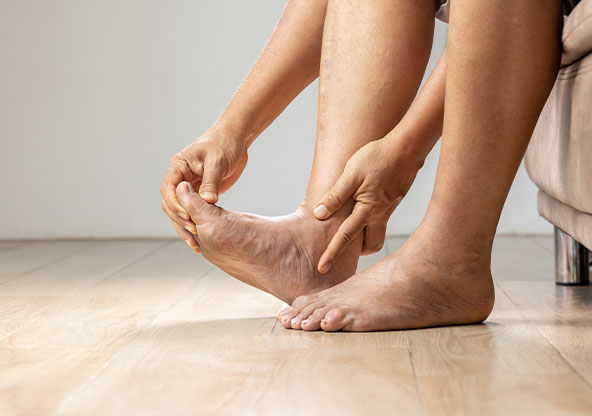How Long Does Gout Last?
The length of gout episodes depends on several health factors: underlying causes, its severity, and whether gout treatment has started.
The frequency and severity of these episodes can vary, and some people may experience them more frequently than others.
Patients diagnosed with gout typically begin their treatment journey by consulting a primary care physician. However, when faced with challenging or unresponsive cases, patients should consider seeking the specialized care of a rheumatologist.
A typical gout episode can last anywhere from 3 to 10 days; if left untreated, these episodes can continue for weeks or months.
What is Gout?
Gout is a type of arthritis that causes the following:
- Sudden severe pain
- Tenderness
- Redness
- Warmth
- Swelling in one or more joints
It commonly affects the big toe but can also affect other joints, such as the ankle, knee, elbow, and wrist.
Gout occurs when too much uric acid builds up in the body. The uric acid forms sharp crystals that deposit in the joints and cause inflammation.
How Long Does Gout Last with Treatment?
The duration of a gout episode with treatment can vary. It depends on how severe the gout is and how quickly a person responds to treatment.
Treatment should begin as soon as possible, as it will help reduce the episode's duration and minimize discomfort and pain.
If you are experiencing a gout episode that has lasted longer than expected or is causing severe pain, you should contact your healthcare provider as soon as possible for further evaluation.
Early treatment is the key to minimizing discomfort and preventing long-term damage to your joints.
How Long Does Gout Last Without Treatment?
Episodes can last several weeks or months if not treated properly, and even years with on-and-off flare-ups.
It is usually intermittent, with periods of remission in between flare-ups. The frequency and severity of gout flares may decrease over time. This is due to the body becoming better able to tolerate higher uric acid levels in the blood.
However, if left untreated, the condition can cause serious long-term damage to the joints, tendons, and organs.
What are Treatments for Gout?
Medications are the quickest way to get rid of gout.
Gout is typically treated with medications that help reduce uric acid levels in the blood. Certain medications also provide pain relief and anti-inflammatory treatment. Medications such as allopurinol or febuxostat are used to reduce the production of uric acid by the body. Colchicine helps decrease inflammation and pain.
Non-steroidal anti-inflammatory drugs (NSAIDs) can help reduce swelling and pain associated with gout attacks: These include:
- Ibuprofen
- Naproxen sodium
- Indomethacin
- In some cases, corticosteroids may be injected into the affected area of your joint for immediate relief.
Who Gets Gout?
Diet and lifestyle choices are thought to play an important role in the risk of gout.
Red meat, seafood, and other food that are rich in purines can increase the amount of uric acid. This leads to a build-up of crystals in the joints.
Being overweight and consuming large amounts of alcohol can also contribute to symptoms.
This condition can affect people of any age, although it is most common in adults ages 40 and older. This condition is more likely to occur in men than women, especially after age 30.
How to Know If You’re Having a Gout Episode
Typical symptoms of gout include:
- Red and tender joints (especially on the big toe)
- Pain that is worse at night or in the morning
- Swelling around the joint
- Difficulty moving the joint due to stiffness and pain
- Heat or warmth around the joint
Fever, chills, nausea, and fatigue often accompany attacks. If you experience any of these symptoms, it is important to contact your doctor for testing and treatment.
What to Eat During Gout
Diet is one of the most important aspects to consider when managing gout. Certain foods can help reduce pain and flare-ups. Some foods may worsen symptoms.
Generally, a person should focus on eating an overall healthy diet full of nutrient-dense foods.
This includes the following foods:
- Plenty of fresh vegetables
- Fruits
- Whole grains
- Nuts and seeds
- Lean proteins such as fish and poultry
- Healthy fats such as olive oil and avocado, and legumes
Limiting or avoiding refined carbohydrates such as white bread, pasta, and processed snacks is also important.
Alcohol should also be avoided or limited. Alcohol can increase uric acid crystal levels in the body and trigger flare-ups.
Where to go to Get Help for Gout
The best place for people with gout to seek help is from a primary healthcare provider.
Your doctor can diagnose and recommend an appropriate course of treatment. A doctor will look at your symptoms, medical history, and any laboratory tests that may have been done.
A primary care doctor will commonly use tests to check for the condition. These include:
- Blood tests: A blood test will measure the levels of uric acid in the blood
- Joint fluid analysis: involves taking a sample of fluid from an affected joint and looking at it under a microscope for signs of inflammation.
- Imaging tests: X-rays, ultrasounds, and MRI scans may be used to detect joint damage
- Urate crystals in urine tests: This involves testing the person’s urine for uric acid crystals.
- Arthrocentesis: In this procedure, a doctor removes fluid from the joint and examines it under a microscope.
